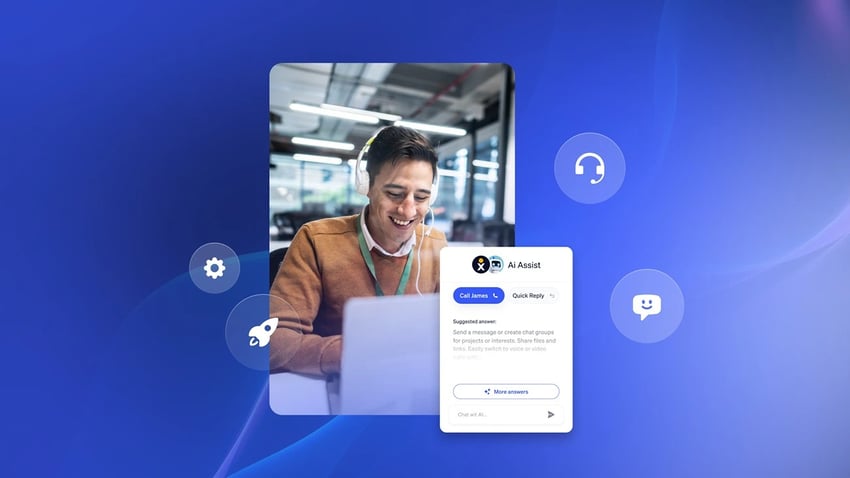Customer service hinges on immediacy, personalization, and context. When customers call, they’re not just looking for answers — they’re seeking connection. And that moment can either reinforce their loyalty or drive them away. Yet too many businesses still rely on disconnected phone systems that turn opportunity into frustration.
With today’s advanced customer experience (CX) technologies, organizations no longer need to settle for clunky experiences, slow agent responses, or missed insights. The Salesforce phone system, for instance, turns every conversation into an opportunity to connect deeply with each customer. Computer telephony integration (CTI) partners like Nextiva, RingCentral, and Five9 extend Salesforce’s potential by unifying workflows and closing feature gaps. Working seamlessly together, these solutions streamline customer experiences.
Salesforce Phone System: Core Capabilities
Salesforce offers a variety of telephony solutions under its customer relationship management (CRM) umbrella. Together, these capabilities create a robust, though at times fragmented, phone support infrastructure.
1. Native voice capabilities
Salesforce has native voice capabilities built into its Service Cloud platform. Agents can access customer data and full CRM context during calls to provide personalized experiences. Features like real-time transcription and AI-suggested responses further guide agents’ next steps and help them address customer concerns.
The platform also supports click-to-dial outbound calling. Local caller ID masking, voicemail drop, and automatic call logging help teams shift from reactive problem-solving to proactive relationship-building.
2. Real-time transcription and conversation intelligence
Salesforce Einstein enables agents to stay focused on the conversation by leveraging AI to provide real-time transcription with contextual recommendations for more meaningful customer engagement.
After the call, Einstein generates valuable analytics. It surfaces customer sentiment, detects objections, and identifies potential compliance triggers. Beyond helping resolve individual issues, this advanced conversation intelligence aids in crafting a long-term CX strategy.

3. CTI and partner integration
With Open CTI, businesses can embed trusted third-party voice providers like Nextiva, RingCentral, Dialpad, and Five9 directly into the Salesforce platform. Native integration with Amazon Connect also offers out-of-the-box functionality, reducing implementation complexity.
These integration capabilities position voice as a dynamic touchpoint in a unified digital experience, giving agents centralized access to customer data and enabling more consistent, context-aware service.
4. Intelligent call routing and IVR
Intelligent call routing and IVR capabilities in Salesforce allow businesses to meet customer expectations while minimizing operational complexity. Phone calls can be routed based on prior interactions, agent skillsets, availability, and even customer intent, ensuring every call reaches the right resource or is efficiently automated.
Advanced AI tools like Agentforce further streamline routing processes by surfacing relevant knowledge, triggering workflows, or escalating urgent issues based on real-time context.
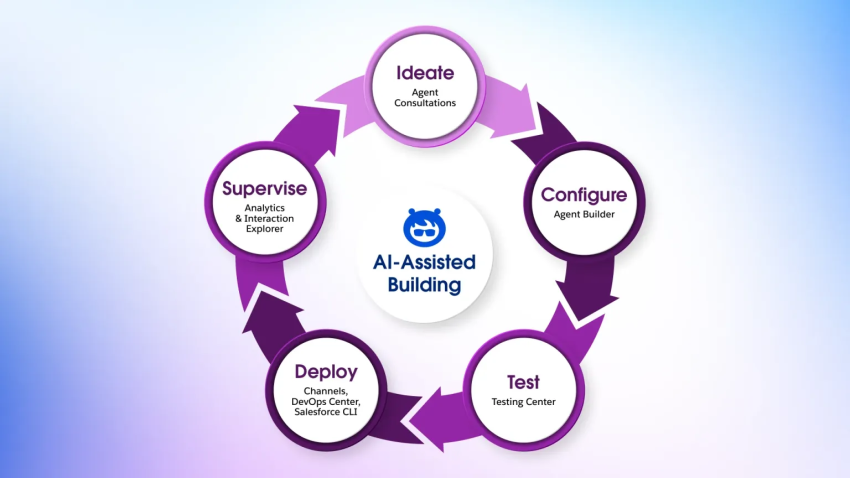
5. Omnichannel and mobile support
One of the most common sources of customer frustration is being transferred between multiple agents and asked to repeat the same information across channels. Salesforce addresses this by integrating phone, SMS, live chat, social, and other channels into a single unified console. Click-to-call and softphones built into mobile apps help maintain consistent support, even when customer service teams are remote or on the move.
These omnichannel and mobile capabilities empower organizations to meet customers where they are, improve response times, and deliver more cohesive interactions.
6. Supervisor tools
High-performing teams rely on timely insights to guide their decision-making. With tools like Omni Supervisor and contact center analytics, Salesforce provides real-time visibility into queues, agent status, and in-progress customer interactions.
Beyond this, integrated coaching tools, collaboration through Slack or chat, and AI-driven sentiment analysis allow leaders to support and guide agents during live interactions, transforming conversations into learning opportunities. With access to key metrics like customer satisfaction, SLA performance, and handle times, leaders can identify performance gaps, scale best practices, and adapt their strategies in line with evolving customer needs.
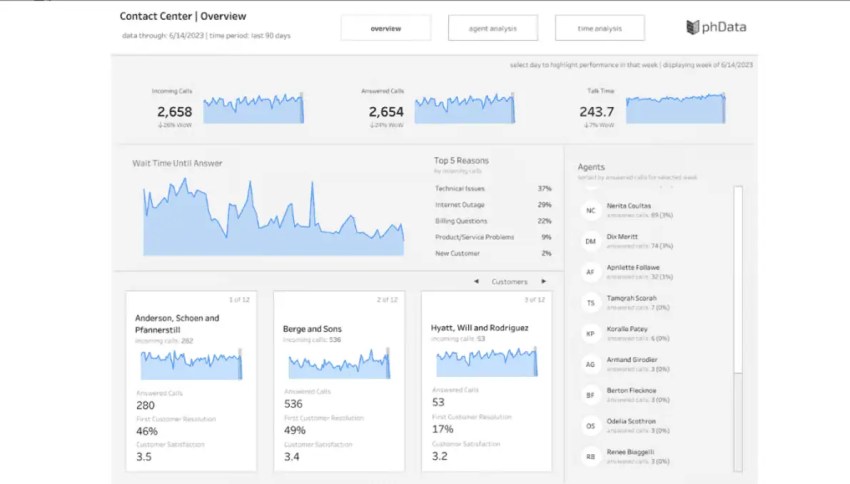
Limitations of Salesforce’s Phone System
While the Salesforce phone integration system offers strong functionality, it is not built to serve as a comprehensive enterprise phone system. Organizations relying solely on Salesforce-native voice capabilities may encounter some limitations, including the following:
Complex setup and costs
Salesforce’s voice capabilities are highly modular, allowing organizations to tailor solutions to their needs. However, this also means that building a complete voice system often requires multiple components, each with its own cost. For instance, Service Cloud Voice with 5,000 minutes is currently priced at $200 per user per month, excluding usage-based Amazon Connect charges or third-party CTI partner licensing.
The real total cost of ownership can rise sharply as you scale across departments or regions. Additionally, the implementation process is not always straightforward. Many teams underestimate the development and configuration effort needed to fully activate and optimize voice workflows.
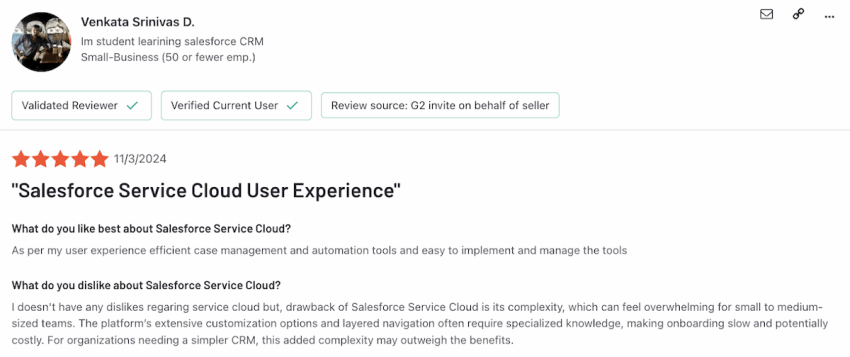
Fragmented user experience
Depending on the CTI partner selected, agents may need to navigate multiple interfaces to access caller information, notes, or AI guidance. Some integrations may lack key features like voicemail transcription, call summaries, or mobile support.
These fragmented tools and processes make it difficult to create a consistent agent experience. As a result, organizations may face reduced productivity, slower onboarding, and missed opportunities for actionable insight. All of these can negatively affect the customer experience.
Limited global calling (Sales Dialer)
Salesforce’s Sales Dialer currently supports calling only within the U.S. and Canada. As a result, it may not meet the needs of global enterprises or distributed sales teams operating across regions and time zones that require a comprehensive sales enablement solution. To extend calling capabilities beyond North America, organizations must rely on external CTI partners or telephony platforms, introducing additional complexity and cost.
Third-party reliance
Salesforce requires integration with Amazon Connect, Genesys, or other CTI partners. As such, Service Cloud Voice is only as effective as the telephony provider behind it.
This introduces two strategic risks: limited reliability and increased complexity. Your customer experience is only as dependable as your chosen provider’s uptime and call quality. Custom integrations often require technical expertise, development resources, and ongoing maintenance to prevent system drift and performance issues.
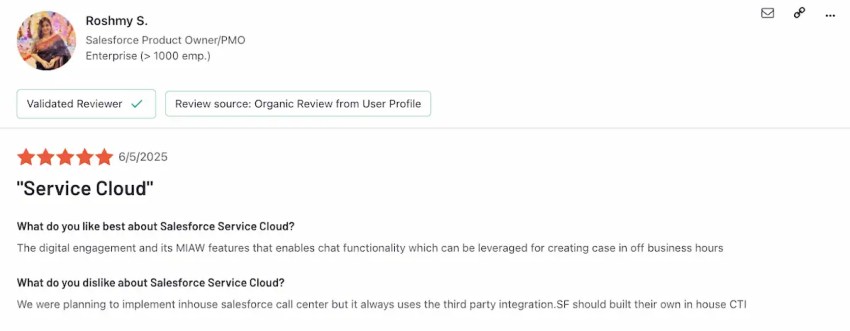
As customer expectations rise and operations expand globally, leaders must evaluate whether the native phone experience is supporting performance or introducing friction that limits their teams.
Why You Might Look for a Salesforce Phone System Alternative
While Salesforce is a reliable platform for CRM-driven engagement, its native capabilities often lack the comprehensive solutions needed for voice and omnichannel communications. Some organizations end up stitching together modular features, managing multiple vendors, and navigating usage-based pricing models that don’t scale efficiently.
If your organization is focused on growth, speed, and unified service delivery, consider evaluating alternatives that go beyond Salesforce’s voice offerings. The right CTI partner won’t just streamline call management; it will help build a scalable, agile, and insight-driven customer engagement strategy.
You may benefit from a more comprehensive solution if:
- You require a unified communication platform that consolidates voice, SMS, chat, and video for inbound and outbound calls, not just siloed modules within Salesforce.
- You prioritize cost predictability and want to avoid per-minute or usage-based pricing models.
- You have a hybrid or distributed workforce and need seamless agent experiences across desktop, mobile, and embedded CRM views.
- You want faster time to value, without complicated Open CTI development, complex partner configurations, or fragmented integrations.
A modern contact center platform should accelerate transformation, not complicate it. Evaluating the right partner now can position you to meet rising customer expectations with speed, clarity, and confidence.
Top 3 Salesforce Phone System Alternatives
If Salesforce lacks the capabilities you require for streamlined customer and agent experiences, business agility, and operational scale, it may be time to explore alternative solutions built for enterprise-grade communications.
Nextiva: Best all-in-one Salesforce phone system integration

For organizations looking to elevate their CRM into a centralized hub for customer communication, consider integrating Nextiva with Salesforce. Functioning as more than a standalone dialer, Nextiva transforms voice into a real-time, insight-rich engagement tool that’s fully embedded within your CRM.
What sets it apart:
- Deep CRM integration with Salesforce Lightning and Classic, including softphone, screen pops, and auto-logging
- Real-time transcription and NLP-powered follow-up actions, streamlining post-call work
- Intelligent call routing that leverages CRM data to match callers with the right agent
- Enterprise-grade mobile support to ensure consistent productivity across remote and on-site teams
- Reliability and trust backed by 99.999% uptime and certifications like HIPAA and SOC 2
Best for:
Mid-market to enterprise teams looking to consolidate communications, boost agent productivity, and improve response times — without the complexity of managing multiple platforms or overinvesting in unnecessary features.

RingCentral: Best for global voice and omnichannel features

With tens of thousands of partners worldwide, RingCentral brings scale, international reach, and omnichannel capabilities to Salesforce environments. For global enterprises or those expanding operations, this platform can extend voice capabilities across geographies and devices. Moreover, its built-in analytics and strong customer relationship management integrations enhance customer intelligence.
What sets it apart:
- Native Salesforce integration through the RingCentral for Salesforce app
- Global infrastructure supporting VoIP in 46+ countries
- A unified platform combining voice, SMS, fax, video, and team messaging
- Advanced analytics with AI-powered call transcription and performance insights
- Workflow automation and screen pops that drive CRM adoption
Best for:
Large sales teams and multinational organizations that need enterprise-grade voice features with international phone numbers, consistent agent experiences, and strong compliance coverage in regulated industries.
Five9: Best for AI-powered contact center automation

For organizations that rely heavily on outbound campaigns or high-volume customer interactions, Five9 can bring AI-driven automation and intelligent workflows directly into the Salesforce CRM platform. As a cloud-based contact center solutions provider, it offers predictive dialers, speech analytics, and robust integrations, without costly subscriptions.
What sets it apart:
- A full suite of predictive, power, and progressive dialers
- AI-driven speech analytics and real-time sentiment detection
- Embedded Salesforce console for agent workflows
- Omnichannel engagement across voice, chat, email, and social media
- Integrated campaign tools for workflow automation and compliance
Best for:
Outbound call centers and enterprise support teams that need high-volume dialing, intelligent automation, and AI-driven coaching.
When choosing a CTI solution, prioritize the tool that aligns with your current operational requirements and can scale with your long-term strategy. The right partner connects insights, teams, and experiences.
Nextiva: The Ideal Salesforce Phone System Partner
While Salesforce’s native telephony options provide a strong foundation, pairing them with a unified communications platform like Nextiva delivers a more cohesive and agile approach to enterprise communications.
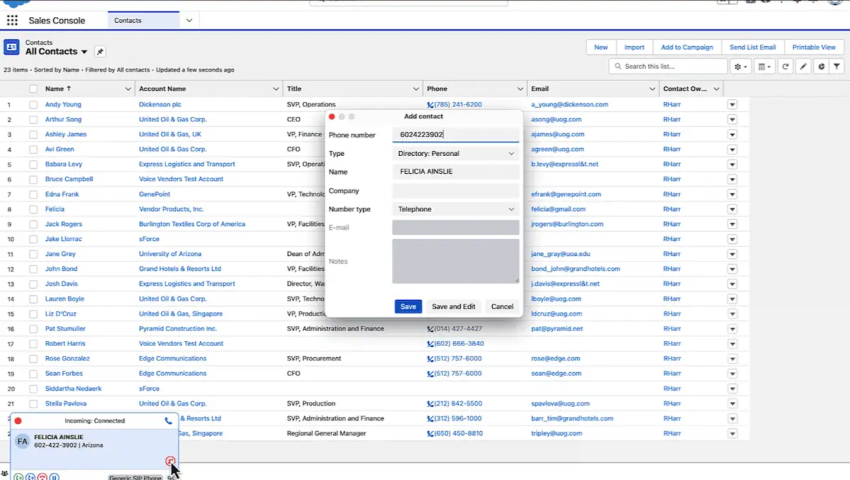
- Unified customer experience management (CXM). Nextiva provides a unified CXM. Teams can manage voice, SMS, customer sentiment, surveys, and follow-ups from a single, streamlined dashboard. It helps turn fragmented customer touchpoints into a cohesive journey for both agents and customers.
- Rapid low-code deployment. Nextiva offers streamlined onboarding. With its no-code configuration and seamless Salesforce integration, most teams are operational within days, not weeks or months, minimizing disruption and accelerating ROI.
- AI that drives productivity, not complexity. Nextiva ensures AI delivers practical value. Its embedded AI goes beyond call analysis, providing automatic call summaries, contextual next steps, coaching tips, and more — right inside your CRM workflow.
- Transparent, scalable pricing. Nextiva’s flexible pricing model offers transparency and cost control. Unlike opaque minute-based pricing models or bloated bundles, you pay only for the capabilities you need. This enables easier forecasting as you scale.
If your focus is on turning every customer interaction into a measurable business advantage, Nextiva delivers the technology and flexibility to support that goal.
Make Your Next Call a Good One: Choose the Right Partner
Modern customer experiences are becoming more complex as expectations evolve and needs diversify. To stay ahead, you need partners who can empower your teams, provide resilient support, and deliver scalable infrastructure. Align your technology choices with your broader experience ecosystem so you can scale faster, adapt smarter, and serve customers more personally. Choose contact center platforms like Nextiva that enable you to create smarter, more connected experiences for the people who matter most to your business.
Smart CX isn’t built on technology alone; it’s built on strategic partnerships and the ability to adapt without starting over from scratch.
Top Ranked AI-Powered Contact Center Solution
Transform your customer interactions with a contact center platform that saves you time and money, reduces agent and supervisor stress, and flexibly adapts to fit your needs.

















 Business Communication
Business Communication 








